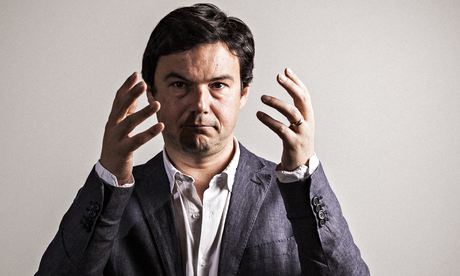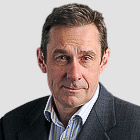'People will forgive you for being wrong, but they will never forgive you for being right - especially if events prove you right while proving them wrong.' Thomas Sowell
Search This Blog
Showing posts with label Piketty. Show all posts
Showing posts with label Piketty. Show all posts
Friday, 28 January 2022
Wednesday, 19 February 2020
Saturday, 18 November 2017
Income inequality in India
Varsha Kulkarni and Raghav Gaiha in The Hindu
With the Gujarat State elections barely a few weeks away, the debate on the Indian economy has become increasingly polarised. While the official view of demonetisation unleashed in November 2016 elevates it to a moral and ethical imperative, the chaos caused by the goods and services tax (GST) launched on July 1, 2017, is dismissed as a short-run transitional hiccup. Both policies, it is asserted, are guaranteed to yield long-term benefits, unmindful of large-scale hardships, loss of livelihoods, closure of small and medium enterprises and slowdown of agriculture. Critics of course reject these claims lock, stock and barrel. Lack of robust evidence is as much a problem for the official proponents of these policies as it is for the critics. Hence the debate continues unabated with frequent hostile overtones.
Tracking income inequality
Beneath the debate are deep questions of inequality and its association with poverty. Thomas Piketty produced a monumental treatise, Capital in the Twenty-First Century, demonstrating that rising income inequality is a by-product of growth in the developed world. More recently, Lucas Chancel and Piketty (2017), in ‘Indian income inequality, 1922-2014: From British Raj to Billionaire Raj?’, offer a rich and unique description of evolution of income inequality in terms of income shares and incomes in the bottom 50%, the middle 40% and top 10% (as well as top 1%, 0.1%, and 0.001%), combining household survey data, tax returns and other specialised surveys.
Some of the principal findings are: one, the share of national income accruing to the top 1% income earners is now at its highest level since the launch of the Indian Income Tax Act in 1922. The top 1% of earners captured less than 21% of total income in the late 1930s, before dropping to 6% in the early 1980s and rising to 22% today. Two, over the 1951-1980 period, the bottom 50% captured 28% of total growth and incomes of this group grew faster than the average, while the top 0.1% incomes decreased. Three, over the 1980-2014 period, the situation was reversed; the top 0.1% of earners captured a higher share of total growth than the bottom 50% (12% v. 11%), while the top 1% received a higher share of total growth than the middle 40% (29% v. 23%).
True to its modest objective, it offers a rich and insightful description of how income distribution, especially in the upper tail, and inequality have evolved.
Sharp reduction in the top marginal tax rate, and transition to a more pro-business environment had a positive impact on top incomes, in line with rent-seeking behaviour.
India’s wealth gain
According to Credit Suisse Global Wealth Report 2017, the number of millionaires in India is expected to reach 3,72,000 while the total household income is likely to grow by 7.5% annually to touch $7.1 trillion by 2022. Since 2000, wealth in India has grown at 9.2% per annum, faster than the global average of 6% even after taking into account population growth of 2.2% annually. However, not everyone has shared the rapid growth of wealth.
Our research, based on the India Human Development Survey 2005-12, focusses on a detailed disaggregation of income inequality, along the lines of Chancel and Piketty, recognising that incomes in the upper tail are under-reported; and examines the links between poverty and income inequality, especially in the upper tail, state affluence, and prices of cereals.
Our analysis points to a rise in income inequality. A high Gini coefficient of per capita income distribution, a widely used measure of income inequality, in 2005 became higher in 2012. The share of the bottom 50% fell while those of the top 5% and top 1% rose. The gap between the share of the top 1% and the bottom 50% narrowed considerably.
More glaring is the disparity in ratios of per capita income of the top 1% and bottom 50%. The ratio shot up from 27 in 2005 to 39 in 2012. Far more glaring is the disparity in the highest incomes in these percentiles. The ratio of highest income in the top 1% to that of the bottom 50% nearly doubled, from a high of 175 to 346.
All poverty indices including the head-count ratio fell but slightly.
Poverty and inequality
Higher incomes reduced poverty substantially. Inequality measured in terms of share of income of the top 10% increased poverty sharply but only in the more affluent States. Somewhat surprisingly, higher cereal prices did not have a significant positive effect on poverty. Similar results are obtained if the share of the top 10% is replaced with the Gini coefficient as a measure of inequality.
It is plausible that poverty reduction slowed in 2016-17 because of deceleration of income growth; and huge shocks of demonetisation and the GST to the informal sector have aggravated income inequality. Indeed, depending on the magnitudes of these shocks, poverty could have risen during this period.
In sum, regardless of the longer-term outlook and presumed but dubious benefits of the policy shocks, the immiseration of large segments of the Indian population was avoidable.
With the Gujarat State elections barely a few weeks away, the debate on the Indian economy has become increasingly polarised. While the official view of demonetisation unleashed in November 2016 elevates it to a moral and ethical imperative, the chaos caused by the goods and services tax (GST) launched on July 1, 2017, is dismissed as a short-run transitional hiccup. Both policies, it is asserted, are guaranteed to yield long-term benefits, unmindful of large-scale hardships, loss of livelihoods, closure of small and medium enterprises and slowdown of agriculture. Critics of course reject these claims lock, stock and barrel. Lack of robust evidence is as much a problem for the official proponents of these policies as it is for the critics. Hence the debate continues unabated with frequent hostile overtones.
Tracking income inequality
Beneath the debate are deep questions of inequality and its association with poverty. Thomas Piketty produced a monumental treatise, Capital in the Twenty-First Century, demonstrating that rising income inequality is a by-product of growth in the developed world. More recently, Lucas Chancel and Piketty (2017), in ‘Indian income inequality, 1922-2014: From British Raj to Billionaire Raj?’, offer a rich and unique description of evolution of income inequality in terms of income shares and incomes in the bottom 50%, the middle 40% and top 10% (as well as top 1%, 0.1%, and 0.001%), combining household survey data, tax returns and other specialised surveys.
Some of the principal findings are: one, the share of national income accruing to the top 1% income earners is now at its highest level since the launch of the Indian Income Tax Act in 1922. The top 1% of earners captured less than 21% of total income in the late 1930s, before dropping to 6% in the early 1980s and rising to 22% today. Two, over the 1951-1980 period, the bottom 50% captured 28% of total growth and incomes of this group grew faster than the average, while the top 0.1% incomes decreased. Three, over the 1980-2014 period, the situation was reversed; the top 0.1% of earners captured a higher share of total growth than the bottom 50% (12% v. 11%), while the top 1% received a higher share of total growth than the middle 40% (29% v. 23%).
True to its modest objective, it offers a rich and insightful description of how income distribution, especially in the upper tail, and inequality have evolved.
Sharp reduction in the top marginal tax rate, and transition to a more pro-business environment had a positive impact on top incomes, in line with rent-seeking behaviour.
India’s wealth gain
According to Credit Suisse Global Wealth Report 2017, the number of millionaires in India is expected to reach 3,72,000 while the total household income is likely to grow by 7.5% annually to touch $7.1 trillion by 2022. Since 2000, wealth in India has grown at 9.2% per annum, faster than the global average of 6% even after taking into account population growth of 2.2% annually. However, not everyone has shared the rapid growth of wealth.
Our research, based on the India Human Development Survey 2005-12, focusses on a detailed disaggregation of income inequality, along the lines of Chancel and Piketty, recognising that incomes in the upper tail are under-reported; and examines the links between poverty and income inequality, especially in the upper tail, state affluence, and prices of cereals.
Our analysis points to a rise in income inequality. A high Gini coefficient of per capita income distribution, a widely used measure of income inequality, in 2005 became higher in 2012. The share of the bottom 50% fell while those of the top 5% and top 1% rose. The gap between the share of the top 1% and the bottom 50% narrowed considerably.
More glaring is the disparity in ratios of per capita income of the top 1% and bottom 50%. The ratio shot up from 27 in 2005 to 39 in 2012. Far more glaring is the disparity in the highest incomes in these percentiles. The ratio of highest income in the top 1% to that of the bottom 50% nearly doubled, from a high of 175 to 346.
All poverty indices including the head-count ratio fell but slightly.
Poverty and inequality
Higher incomes reduced poverty substantially. Inequality measured in terms of share of income of the top 10% increased poverty sharply but only in the more affluent States. Somewhat surprisingly, higher cereal prices did not have a significant positive effect on poverty. Similar results are obtained if the share of the top 10% is replaced with the Gini coefficient as a measure of inequality.
It is plausible that poverty reduction slowed in 2016-17 because of deceleration of income growth; and huge shocks of demonetisation and the GST to the informal sector have aggravated income inequality. Indeed, depending on the magnitudes of these shocks, poverty could have risen during this period.
In sum, regardless of the longer-term outlook and presumed but dubious benefits of the policy shocks, the immiseration of large segments of the Indian population was avoidable.
Tuesday, 27 May 2014
Thomas Piketty's real challenge was to the FT's Rolex types
If the FT's attack on the radical economist's 'rising inequality' thesis is right, then all the gross designer bling in its How To Spend It section can be morally justified

The adverts in the FT and other reputable papers – mainly for large watches, first-class air travel, portable fine art etc – should be collectively retitled How To Hide It
Thomas Piketty's Capital was still No 3 on the Amazon bestseller list when the Financial Times dropped its front-page bombshell. By picking through the spreadsheets the "rock-star French economist" had placed online, the FT concluded that his key data appeared to be "constructed out of thin air".
Piketty's claim that inequality in the west has risen since the 1970s is wrong, says the FT's Chris Giles. And on this basis, Piketty's view that rising inequality is the central contradiction of capitalism, and will get worse, is also wrong.
It is always right to trawl through data. There is so much grossing and smoothing in economics, and so little of the realtime peer review that happens in science, that data should always be challengable. But the gleeful response to Piketty's "errors" on the rightwing Twittersphere did not happen because some FT pointy-heads discovered a few fat-finger inputs. It happened because, if Giles is right, then all the gross designer bling advertised in the FT's How To Spend It can be morally justified: it is evidence of rising social wealth in general, not the excess of a few Rolex types.
But the attack does not quite come off. For Sweden and France, the FT's conclusions barely diverge from Piketty's. For Britain and the US they do: the official figures capture the general curve of inequality downwards in the mid-20th century, but shatter into incoherence after 1970, failing to match Piketty's claim that wealth inequalities have increased.
There is an obvious reason for this: since time immemorial the rich have been averse to declaring their wealth. But after 1979 capitalism was restructured to promote wealth accumulation, ending the "euthanasia of the rentier" Keynes had designed into the postwar system.
Unlike income, which has been vigorously taxed since the mid-19th century and therefore recorded, personal wealth was, after 1979, the subject of a half-hearted cat-and-mouse game in which the cat and the mouse were wont to share yachting trips to the Aegean on a regular basis. That's why the work of Piketty and his collaborators had to be based on a mixture of inheritance tax data and surveys, plus a large amount of calculation.
Piketty's figures show a clear upward trend to inequality in the UK since the 70s; the FT's preferred official data dissolves into a series of squiggles that show nothing conclusive. And let's be clear why: the HMRC currently estimates that the top 10% of the population own 70% of the wealth, while the Office for National Statistics thinks they own just 44%. The discrepancy occurs because, of course, there is neither requirement nor desire to record actual market wealth at all. There are only inheritance tax returns on estates big enough to pay it.
The old Inland Revenue figures for UK wealth were so wonky that they abandoned efforts to calculate them: but in their last attempt (2005) they said that on top of £3.4tn "identified" wealth in the UK, a further £1.7tn had to be assumed that was either not declared or belonged to people who slipped through the net.
For this reason one of Piketty's key demands is the automatic sharing of bank information between states and banks. The principle is simple, he writes: "National tax authorities should receive all the information they need to calculate the net wealth of every citizen." Why that might be needed is understood if you flick through the wealth management magazines produced by the FT and other reputable papers. The adverts – mainly for large watches, first-class air travel, portable fine art, tax haven accountants and capacious luggage – deliver a clear subliminal message. They should be collectively retitled "How To Hide It".
In the end, Piketty did not claim there had been a vast increase in wealth disparities since the 1970s. Piketty's prediction is that the moderate rise in inequality under neoliberalism is set to gather pace in the 21st century, taking us back to Victorian levels by 2050. His prediction is based on simple maths: if growth is low, and the bargaining power of labour low, and the returns on capital high, then it is more logical to sit on assets and speculate rather than accumulate wealth by work, invention or entrepreneurial risk.
Piketty asks the question that mainstream economics doesn't want to answer: do we want a society based on work and ingenuity or on rent?
It's not an academic question. Figures from Lloyds Private Bank show UK asset wealth grew from £4.7tn to £7.8tn in the decade to 2013, with most of that generated by the rising value of financial portfolios, and all wealth growing faster than incomes and inflation. If Piketty's figures are wrong, the probable cause – beyond the odd transcription error – is a mild overestimation of a clear trend, generated in an attempt to uncover modern capitalism's guilty secret. If the FT's figures are wrong, it is because they rely on those of governments that have become – as Peter Mandelson once put it – "intensely relaxed about people becoming filthy rich".
But the most important question is the future: if Piketty is right then we have to "euthanase" the rentier class all over again. Only taxes on current wealth – and an end to opaque "wealth management" trails that end up in Switzerland or Cyprus – will prevent capitalism generating levels of social inequality that destroy it.
Paul Mason is economics editor at Channel 4 News and the author of Why It's Kicking Off Everywhere.
Sunday, 25 May 2014
Thomas Piketty's economic data 'came out of thin air'
French economist's bestselling book on growing inequality in west undermined by 'inexplicable' data, says Financial Times

French economist Thomas Piketty says his data can be improved but the conclusion on growing inequality is unlikely to change. Photograph: Rex Features
Only a few days ago, the "rock star" economist Thomas Piketty had the world at his feet. He had lectured at the White House, the International Monetary Fund and the United Nations.
His 577-page Capital in the Twenty-First Century, an unexpected bestseller, was economics' answer to The Da Vinci Code. Based on a simple premise – that the dynamics of wealth accumulation are causing global inequality levels to widen – it was lauded by economists and business leaders alike.
Lord Turner, the former chairman of the Financial Services Authority, described Capitalas "a remarkable piece of work," while the Nobel prizewinning economist, Paul Krugman, writing in the New York Review of Books, said Piketty's work will "change both the way we think about society and the way we do economics".
Now, in a move that has delighted his manifold critics on the right, who view Piketty's tome as a dangerous, modern-day successor to Karl Marx's Das Kapital, the 43-year-old French economist has found himself attracting a less welcome form of attention. The Financial Times has suggested that Piketty's work contains a series of errors that appear to fatally undermine large parts of his thesis. The normally restrained paper claims that some of the data Piketty uses to support his arguments about yawning inequality in Britain and Europe are dubious or inexplicable. Some of this, the paper suggests, may be down to straightforward transcription errors. More damningly, the FTclaims, "some numbers appear simply to be constructed out of thin air".
The paper goes as far as to suggest its findings are similar to those last year that undermined the work of the Harvard economists, Carmen Reinhart and Kenneth Rogoff, which analysed the relationship between growth and debt and was subsequently found to have been based on a flawed spreadsheet.
Bloomberg described the claims as a bombshell and there has been no shortage of commentators suggesting the story is huge. Some on the right have also been gleeful, suggesting the FT's story will scupper Piketty's chances of landing a Nobel prize. But, as the dust settles, even many of his critics have been reluctant to claim that Piketty has been left badly wounded by an impenetrable row over the selection and interpretation of data, nor do they accept that the FT's claims have done much to damage his over-arching thesis.
Piketty himself told the FT: "I have no doubt that my historical data series can be improved and will be improved in the future … but I would be very surprised if any of the substantive conclusion about the long-run evolution of wealth distributions was much affected by these improvements." It was Piketty who made the data freely available so that others could check his work and influential publications and think tanks have given him their backing.
The Economist concluded that "analysis does not seem to support many of the allegations made by the FT, or the conclusion that the book's argument is wrong".
If anything the row has fuelled further interest in a book that is still in Amazon's top 20 and has reportedly sold more than 200,000 copies, an unprecedented amount for an economics book.
Declan Gaffney, writing on the Institute for Public Policy Research blog, concluded: "No doubt that framework will be modified over time in the light of new evidence and theory, but it seems likely that we will be looking at wealth concentration and broader aspects of economic and social change through the lens of Capital for a long time to come."
For the lay person attempting to referee the row, and having to interpret such abstruse concepts as the Gini coefficient and, as Gaffney neatly summarises, whether "the r > g inequality is amplifying the reconcentration trend", illumination is hard to discern. For its critics, further confirmation of why economics is called the dismal science.
Sunday, 13 April 2014
Capitalism simply isn't working and here are the reasons why
Economist Thomas Piketty's message is bleak: the gap between rich and poor threatens to destroy us

Thomas Piketty has mined 200 years of data to support his theory that capitalism does not work. Photograph: Ed Alcock for the Observer
Suddenly, there is a new economist making waves – and he is not on the right. At the conference of the Institute of New Economic Thinking in Toronto last week, Thomas Piketty's book Capital in the Twenty-First Century got at least one mention at every session I attended. You have to go back to the 1970s and Milton Friedman for a single economist to have had such an impact.
Like Friedman, Piketty is a man for the times. For 1970s anxieties about inflation substitute today's concerns about the emergence of the plutocratic rich and their impact on economy and society. Piketty is in no doubt, as he indicates in an interview in today's Observer New Review, that the current level of rising wealth inequality, set to grow still further, now imperils the very future of capitalism. He has proved it.
It is a startling thesis and one extraordinarily unwelcome to those who think capitalism and inequality need each other. Capitalism requires inequality of wealth, runs this right-of-centre argument, to stimulate risk-taking and effort; governments trying to stem it with taxes on wealth, capital, inheritance and property kill the goose that lays the golden egg. Thus Messrs Cameron and Osborne faithfully champion lower inheritance taxes, refuse to reshape the council tax and boast about the business-friendly low capital gains and corporation tax regime.
Piketty deploys 200 years of data to prove them wrong. Capital, he argues, is blind. Once its returns – investing in anything from buy-to-let property to a new car factory – exceed the real growth of wages and output, as historically they always have done (excepting a few periods such as 1910 to 1950), then inevitably the stock of capital will rise disproportionately faster within the overall pattern of output. Wealth inequality rises exponentially.
The process is made worse by inheritance and, in the US and UK, by the rise of extravagantly paid "super managers". High executive pay has nothing to do with real merit, writes Piketty – it is much lower, for example, in mainland Europe and Japan. Rather, it has become an Anglo-Saxon social norm permitted by the ideology of "meritocratic extremism", in essence, self-serving greed to keep up with the other rich. This is an important element in Piketty's thinking: rising inequality of wealth is not immutable. Societies can indulge it or they can challenge it.
Inequality of wealth in Europe and US is broadly twice the inequality of income – the top 10% have between 60% and 70% of all wealth but merely 25% to 35% of all income. But this concentration of wealth is already at pre-First World War levels, and heading back to those of the late 19th century, when the luck of who might expect to inherit what was the dominant element in economic and social life. There is an iterative interaction between wealth and income: ultimately, great wealth adds unearned rentier income to earned income, further ratcheting up the inequality process.
The extravagances and incredible social tensions of Edwardian England, belle epoque France and robber baron America seemed for ever left behind, but Piketty shows how the period between 1910 and 1950, when that inequality was reduced, was aberrant. It took war and depression to arrest the inequality dynamic, along with the need to introduce high taxes on high incomes, especially unearned incomes, to sustain social peace. Now the ineluctable process of blind capital multiplying faster in fewer hands is under way again and on a global scale. The consequences, writes Piketty, are "potentially terrifying".
For a start, almost no new entrepreneurs, except one or two spectacular Silicon Valley start-ups, can ever make sufficient new money to challenge the incredibly powerful concentrations of existing wealth. In this sense, the "past devours the future". It is telling that the Duke of Westminster and the Earl of Cadogan are two of the richest men in Britain. This is entirely by virtue of the fields in Mayfair and Chelsea their families owned centuries ago and the unwillingness to clamp down on the loopholes that allow the family estates to grow.
Anyone with the capacity to own in an era when the returns exceed those of wages and output will quickly become disproportionately and progressively richer. The incentive is to be a rentier rather than a risk-taker: witness the explosion of buy-to-let. Our companies and our rich don't need to back frontier innovation or even invest to produce: they just need to harvest their returns and tax breaks, tax shelters and compound interest will do the rest.
Capitalist dynamism is undermined, but other forces join to wreck the system. Piketty notes that the rich are effective at protecting their wealth from taxation and that progressively the proportion of the total tax burden shouldered by those on middle incomes has risen. In Britain, it may be true that the top 1% pays a third of all income tax, but income tax constitutes only 25% of all tax revenue: 45% comes from VAT, excise duties and national insurance paid by the mass of the population.
As a result, the burden of paying for public goods such as education, health and housingis increasingly shouldered by average taxpayers, who don't have the wherewithal to sustain them. Wealth inequality thus becomes a recipe for slowing, innovation-averse, rentier economies, tougher working conditions and degraded public services. Meanwhile, the rich get ever richer and more detached from the societies of which they are part: not by merit or hard work, but simply because they are lucky enough to be in command of capital receiving higher returns than wages over time. Our collective sense of justice is outraged.
The lesson of the past is that societies try to protect themselves: they close their borders or have revolutions – or end up going to war. Piketty fears a repeat. His critics argue that with higher living standards resentment of the ultra-rich may no longer be as great – and his data is under intense scrutiny for mistakes. So far it has all held up.
Nor does it seem likely that human beings' inherent sense of justice has been suspended. Of course the reaction plays out differently in different eras: I suspect some of the energy behind Scottish nationalism is the desire to build a country where toxic wealth inequalities are less indulged than in England.
The solutions – a top income tax rate of up to 80%, effective inheritance tax, proper property taxes and, because the issue is global, a global wealth tax – are currently inconceivable.
But as Piketty says, the task of economists is to make them more conceivable. Capital certainly does that.
Subscribe to:
Comments (Atom)

